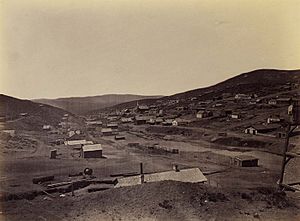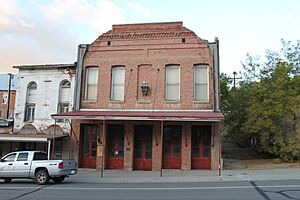Austin, Nevada facts for kids
Quick facts for kids
Austin, Nevada
|
|
|---|---|

Austin in 2004, looking east on U.S. Route 50
|
|
| Country | United States |
| State | Nevada |
| County | Lander |
| Area | |
| • Total | 1.15 sq mi (2.98 km2) |
| • Land | 1.15 sq mi (2.98 km2) |
| • Water | 0.00 sq mi (0.00 km2) |
| Elevation | 6,555 ft (1,998 m) |
| Population
(2020)
|
|
| • Total | 167 |
| • Density | 145.22/sq mi (56.05/km2) |
| Time zone | UTC−8 (Pacific (PST)) |
| • Summer (DST) | UTC−7 (PDT) |
| ZIP codes |
89310
|
| FIPS code | 32-03700 |
| GNIS feature ID | 2583910 |
| Reference #: | 8 |
Austin is a small town in Nevada, United States. It is an unincorporated town, meaning it doesn't have its own local government like a city. Austin used to be the main town, or county seat, of Lander County, Nevada. In 2020, about 167 people lived there. The town is located on the western side of the Toiyabe Range mountains. It sits at a high elevation of about 6,575 feet (2,004 meters). A major road, U.S. Route 50, goes right through the town.
Contents
History of Austin, Nevada
The area where Austin is located was first home to groups of the Western Shoshone people. The town of Austin was planned out in 1862 by David Buell. This was during the American Civil War, and the United States government needed new sources of valuable metals like gold and silver. These metals were important to help pay for the war.
The Silver Rush Begins
Austin was named after Buell's business partner, Alvah Austin. The town grew quickly because of a "silver rush." People say that silver was first found when a Pony Express horse kicked over a rock, and observers saw the shiny metal. In 1862, Austin became the county seat for Lander County. This meant it was the main town where the county government was located. Later, in 1979, the county seat moved to Battle Mountain.
By the summer of 1863, Austin and the nearby Reese River Mining District had more than 10,000 people. Most of these were European Americans who came hoping to find silver. In 1864, the towns of Clifton, Austin, and Upper Austin joined together to form the "City of Austin." The Governor officially approved this in February 1864.
A Unique Fundraiser
In 1864, the town of Austin became famous for a special fundraising event. A man named Reuel Colt Gridley started an unplanned fundraiser. He repeatedly sold a sack of flour at an auction. Each time it was sold, the buyer would donate the money and then offer the sack for sale again. This amazing effort raised over $250,000 for soldiers wounded in the Civil War.
Mining Decline and Later Discoveries
The Nevada Central Railroad was built in 1880 to connect Austin to the main transcontinental railroad at Battle Mountain. However, by this time, the silver boom was already slowing down. The town stopped being an official city in 1881. Most of the major silver mining ended by 1887. There was a small increase in mining activity in the 1910s. In the mid-1950s, people became interested in finding uranium in the area for the new nuclear industry. But the uranium found there wasn't very good quality.
Today, gold and silver mining still happens in the Austin area, but not as much as before. High-quality turquoise is also mined in small amounts. You can find several shops in Austin that make jewelry using this local turquoise.
Geography and Climate
The silver found in Austin is in many thin quartz veins (cracks in rocks). These veins are found within a type of rock called monzonite. The main minerals that contain silver are sulfides, like galena and tetrahedrite.
Mining Challenges
At first, silver was found in oxidized ore near the surface. This silver was easy to get out. But these easy-to-mine deposits ran out quickly. The deeper sulfide ore was much harder to process. It had to be heated (roasted) before the silver could be separated. Because of these extra steps and the narrow veins, only very rich ores could be mined profitably in Austin.
The silver veins in Austin are older and formed deeper underground than other silver areas in Nevada, like the famous Comstock Lode. Also, the silver in Austin often came with other metals like lead, zinc, and copper, but not much gold. Other silver areas often had a lot of gold mixed in.
Weather in Austin
Austin has a cold semi-arid climate. This means it has cold, snowy winters and hot, dry summers.
| Climate data for Austin, Nevada, 1991–2020 normals, extremes 1887–present | |||||||||||||
|---|---|---|---|---|---|---|---|---|---|---|---|---|---|
| Month | Jan | Feb | Mar | Apr | May | Jun | Jul | Aug | Sep | Oct | Nov | Dec | Year |
| Record high °F (°C) | 70 (21) |
70 (21) |
78 (26) |
83 (28) |
93 (34) |
98 (37) |
105 (41) |
100 (38) |
97 (36) |
86 (30) |
79 (26) |
70 (21) |
105 (41) |
| Mean maximum °F (°C) | 57.1 (13.9) |
59.1 (15.1) |
66.6 (19.2) |
74.3 (23.5) |
81.9 (27.7) |
89.9 (32.2) |
95.0 (35.0) |
92.5 (33.6) |
87.3 (30.7) |
77.8 (25.4) |
65.7 (18.7) |
56.7 (13.7) |
95.6 (35.3) |
| Mean daily maximum °F (°C) | 42.2 (5.7) |
43.9 (6.6) |
50.3 (10.2) |
55.5 (13.1) |
65.1 (18.4) |
76.2 (24.6) |
85.9 (29.9) |
83.8 (28.8) |
75.0 (23.9) |
62.1 (16.7) |
49.3 (9.6) |
40.5 (4.7) |
60.8 (16.0) |
| Daily mean °F (°C) | 34.2 (1.2) |
35.0 (1.7) |
40.7 (4.8) |
45.0 (7.2) |
53.9 (12.2) |
63.4 (17.4) |
72.6 (22.6) |
70.8 (21.6) |
62.6 (17.0) |
51.0 (10.6) |
40.0 (4.4) |
32.6 (0.3) |
50.2 (10.1) |
| Mean daily minimum °F (°C) | 26.2 (−3.2) |
26.1 (−3.3) |
31.0 (−0.6) |
34.4 (1.3) |
42.7 (5.9) |
50.6 (10.3) |
59.3 (15.2) |
57.7 (14.3) |
50.2 (10.1) |
39.9 (4.4) |
30.7 (−0.7) |
24.7 (−4.1) |
39.5 (4.1) |
| Mean minimum °F (°C) | 6.4 (−14.2) |
9.6 (−12.4) |
13.5 (−10.3) |
19.1 (−7.2) |
25.6 (−3.6) |
31.8 (−0.1) |
45.7 (7.6) |
42.7 (5.9) |
32.8 (0.4) |
2.01 (−16.66) |
11.3 (−11.5) |
4.5 (−15.3) |
0.8 (−17.3) |
| Record low °F (°C) | −25 (−32) |
−18 (−28) |
−6 (−21) |
3 (−16) |
10 (−12) |
20 (−7) |
31 (−1) |
25 (−4) |
17 (−8) |
2 (−17) |
−7 (−22) |
−20 (−29) |
−25 (−32) |
| Average precipitation inches (mm) | 1.22 (31) |
1.15 (29) |
1.46 (37) |
1.64 (42) |
1.86 (47) |
0.61 (15) |
0.58 (15) |
0.40 (10) |
0.64 (16) |
0.53 (13) |
1.11 (28) |
1.14 (29) |
12.34 (312) |
| Average snowfall inches (cm) | 10.4 (26) |
12.9 (33) |
11.8 (30) |
8.4 (21) |
2.6 (6.6) |
0.9 (2.3) |
0.0 (0.0) |
0.0 (0.0) |
0.3 (0.76) |
0.8 (2.0) |
6.8 (17) |
8.7 (22) |
63.6 (160.66) |
| Average precipitation days (≥ 0.01 in) | 6.1 | 4.6 | 5.7 | 6.2 | 6.4 | 2.8 | 1.9 | 2.2 | 2.4 | 2.0 | 4.1 | 4.8 | 49.2 |
| Average snowy days (≥ 0.1 in) | 4.7 | 4.5 | 4.0 | 3.6 | 1.1 | 0.2 | 0.0 | 0.0 | 0.2 | 0.4 | 3.1 | 4.8 | 26.6 |
| Source 1: NOAA | |||||||||||||
| Source 2: National Weather Service | |||||||||||||
Population Changes in Austin
| Historical population | |||
|---|---|---|---|
| Census | Pop. | %± | |
| 1870 | 1,324 | — | |
| 1880 | 1,679 | 26.8% | |
| 1890 | 1,215 | −27.6% | |
| 1900 | 702 | −42.2% | |
| 1910 | 755 | 7.5% | |
| 1920 | 666 | −11.8% | |
| 1930 | 661 | −0.8% | |
| 1940 | 580 | −12.3% | |
| 1950 | 419 | −27.8% | |
| 1960 | 389 | −7.2% | |
| 1990 | 990 | — | |
| 2000 | 468 | −52.7% | |
| 2010 | 192 | −59.0% | |
| 2020 | 167 | −13.0% | |
In 1863, Austin had about 7,000 people, including those who lived there permanently and those just passing through. After the gold and silver mining slowed down, the number of people living in Austin gradually decreased.
Things to See and Do in Austin
Austin is often called a "living ghost town." This means it's a historic mining town that still has people living in it, but it also has many old buildings that show its past.
Historic Churches
The town has four churches. The Catholic church and the Austin Methodist Church were both built in 1866. The Methodist Church is now used as a community center for the town. The Catholic Church, called St. Augustine's, is being restored to become a cultural center.
The Episcopal church, St. George's, was built in 1878. Some people think it's one of the prettiest old frontier churches still standing, and it's still used regularly. These three churches are recognized as Nevada Historical Marker 67. The fourth church is a newer building built by the Church of Jesus Christ of Latter-day Saints.
Other Historic Buildings
The International Hotel is another famous building. It was first built in Virginia City in 1859 and then moved to Austin in 1863. It still serves food and drinks, but it doesn't rent out rooms anymore. People say the International Hotel is the oldest hotel building in Nevada. Austin has many other historic buildings, some of which are being repaired.
Stokes Castle
Just outside Austin, you can find Stokes Castle. This is a unique three-story stone tower built in the Italian style. It was built in 1897 by Anson Phelps Stokes, a rich businessman from New York who owned parts of the local mines. However, he only lived in it for about a month. After that, it was left empty and fell into disrepair.
Other Important Sites
Besides Stokes Castle and the three old churches, several other places in Austin are listed on the National Register of Historic Places. This list includes important historical sites in the United States. Some of these are the Austin Cemetery, the old city hall, the Austin Masonic and Odd Fellows Hall, the Gridley Store, the former Lander County Courthouse, and Lander County High School. The entire Austin Historic District is also on the list. Toquima Cave, an ancient site near the town with prehistoric drawings, is also listed.
About 15 miles (24 km) east of Austin, there are natural hot springs. Visitors and local volunteers help maintain these springs. The Hickison Petroglyph Recreation Area is about 24 miles (39 km) east of Austin. Here, you can walk a short trail and see ancient drawings carved into the rocks by early people.
Community Services
Austin has a public library. It is part of the Elko-Lander-Eureka County Library System, which serves several counties.
See also
 In Spanish: Austin (Nevada) para niños
In Spanish: Austin (Nevada) para niños





